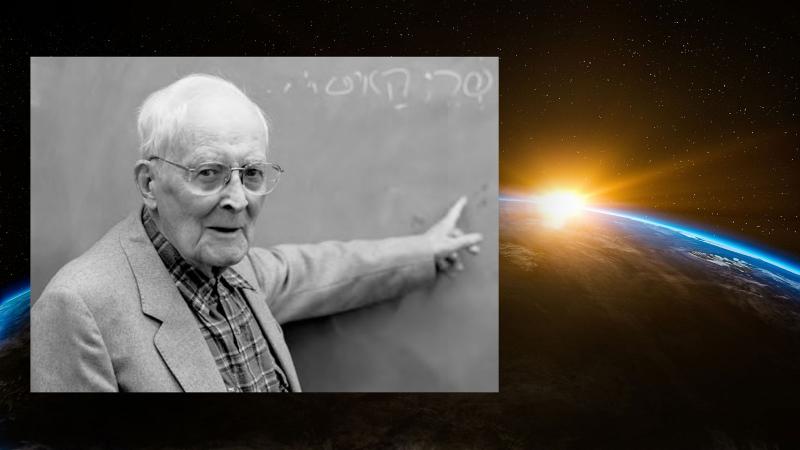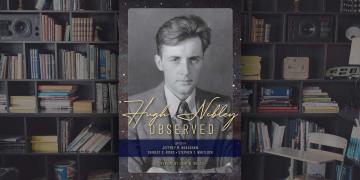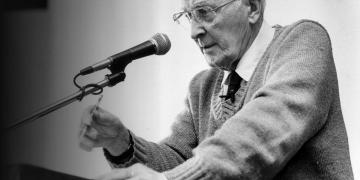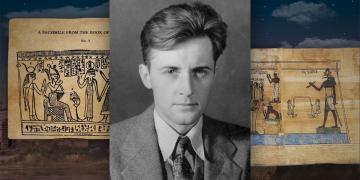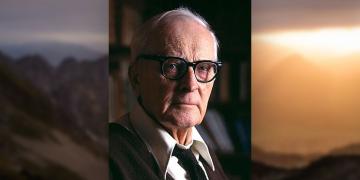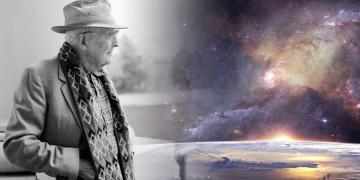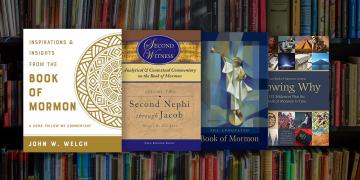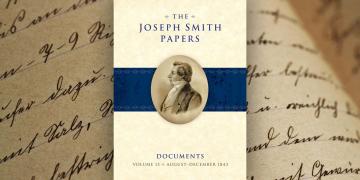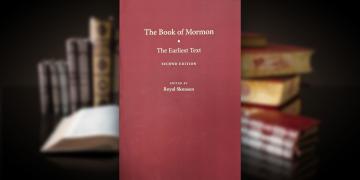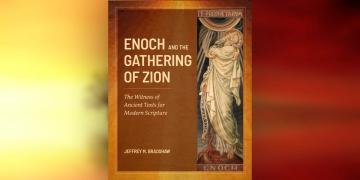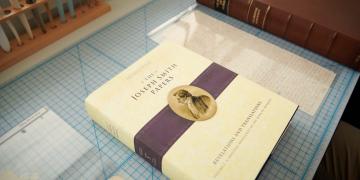You are here
Book of Mormon Central is in the process of migrating to our new Scripture Central website.
We ask for your patience during this transition. Over the coming weeks, all pages of bookofmormoncentral.org will be redirected to their corresponding page on scripturecentral.org, resulting in minimal disruption.
This is the eighth of nine weekly blog posts published in honor of the life and work of Hugh Nibley (1910–2005). The series is in honor of the new, landmark book, Hugh Nibley Observed, available in softcover, hardback, digital, and audio editions. Each week our post is accompanied by interviews and insights in pdf, audio, and video formats. (See the links at the end of this post.)
Somehow, in addition to his continual immersion in ancient records and the pressing religious and social issues of the day, Hugh Nibley managed to keep up with important new developments in an impressive range of scientific subjects: cosmology, physics, and brain science — to name but a few of his chief interests. And one of his lesser-known gems is an essay entitled “Science Fiction and the Gospel.” The expansive framework of the Restored Gospel accommodated new findings in nearly all of these fields without a hitch. However, on the subjects of death before the Fall of Adam and Eve and the origins of humankind, faithful members sometimes disagreed.1
Leaders and members of the Church who made statements strongly expressing the view that no death existed on earth before the Fall generally were not intrinsically unsympathetic to science, but naturally resisted any views that might be seen as compromising authoritatively expressed doctrines relating to the Creation, the Fall, and the Atonement. Likewise, scientifically-trained leaders and members were not typically seeking to subordinate the claims of faith to the program of science, but understandably desired to circumscribe their understanding of truth into “one great whole.”2
In this regard, Elder Harold B. Lee, a staunch advocate of the idea that there was no death before the Fall, spoke approvingly of a story recounted by Latter-day Saint scientist Harvey Fletcher about President Joseph F. Smith’s reply to questions posed to him at BYU about the topic of evolution:3
After listening patiently, he replied: “Brethren, I don’t know very much about science. It has not been my privilege to study… deeply… any of the sciences, but this I do know, that God lives, and that His Son instituted this church here upon the earth for the salvation of men. Now brethren, you have that testimony, and I’ve heard you bear it. It’s your job to try and see how these seeming difficulties can be overcome.”
Consistent with this charge by President Smith, Hugh Nibley, a very well-read amateur scientist, and a faithful disciple-scholar, occasionally stepped into the fray.
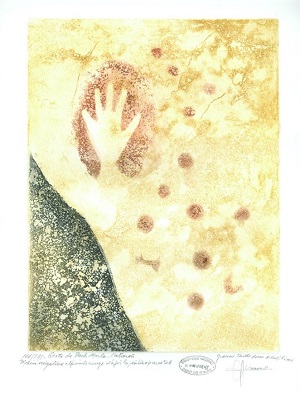
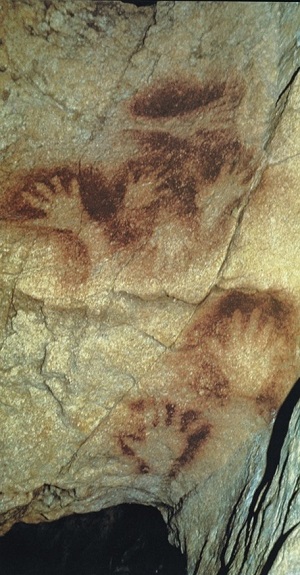
A. Noël Pisano: Negative of Hand and Red Dots, Cavern of Pech-Merle. Cabarets, France, original made ca. 23,000 BC,; B. Seven Hands, Cavern of Pech-Merle, Cabarets, France. A well-honed technique allowed negativse of the hands, surrounded by symbols whose meaning is now is lost to us, to be preserved tens of thousands of years later as ancient snapshots, the sole remaining memories of the lives of these individuals.
Hugh Nibley, with his deep love of God’s creatures,4 had great sympathy for the ancient individuals about whom so much evidence had been discovered and authoritatively dated to long periods that antedated Bible history. He pondered long and hard about how their stories might fit in with those of Adam and Eve. For a thoughtful perspective on this issue, we can do no better than to cite him directly:5
The philosopher Arthur Schopenhauer, in his Essay on the Christian System, said that the two fatal flaws of Christianity were (1) denying spirit and mind to any other creatures but ourselves and (2) allowing life on no other world but our own. …
This … should be no concern [for us]. …
It is Adam as my own parent who concerns me. When he walks onto the stage, then and only then the play begins. He opens a book and starts calling out names. They are the sons of Adam, who also qualify as the sons of God, Adam himself being a son of God. This is the book of remembrance from which many have been blotted out.
Is the Bible a comprehensive history of every individual and creature that has ever lived on earth? By way of analogy, it should be remembered that the Book of Mormon, as a history of those who were Nephites by lineage or “adoption,” records only incidentally the story of the Lamanites and their associates.6 So also the Book of Moses tells us very little about the history of the Cainites or of the children of Adam that were born before Cain and Abel7 who “followed Satan by choice and were disqualified as sons of God.”8 The account instead focuses on the inauguration of temple ordinances among the righteous, which began, as Nibley indicates, “when God set them apart, gave them a blessing, gave them a new name, [and] registered them in the new Book of the Generations of Adam.”9
In light of what scripture tells us, how do we account for the results of genetic studies indicating that every person who has ever lived on earth is descended from a common population of, perhaps, 10,000 founders who lived 100,000 to 150,000 years ago — long before Adam and Eve entered mortality?10 Drawing on the richer sources of scripture produced through modern revelation, Nibley raised a series of questions with an eye to finding scriptural support for surviving non-Adamic and non-Noachian lineages that might help explain such findings:
What about those people who lived before Cain and Abel?11 What about those who disappeared from sight?12 What about those who were not even warned of the Flood?13 … What about the comings and goings of Enoch’s day between the worlds?14 Who were his people … ?15 … What about the creatures we do not see around us?16 Speaking of Noah, … “the Lord said: Blessed is he through whose seed Messiah shall come.”17 Methuselah boasted about his line as something special.18 Why special if it included the whole human race? These blessings have no meaning if all the people of the earth and all the nations are the seed of Noah and Enoch. What other line could the Messiah come through? Well, there were humans who were not invited by Enoch’s preaching.19
Nibley no doubt was wondering whether some of these shadowy peoples described in scripture might be neither descendants of Noah nor of Adam but rather distantly related contemporaries whose descendants may have mixed at various times with the Adamic lineage.20 Fortunately, as Ryan Parr reminds us, blessings promised through of descendance from patriarchs such as Abraham, Isaac, and Jacob are to be ultimately confirmed through the keeping of covenants associated with the sealing ordinances, not by genetics, since specific “nuclear DNA finding its way from any one of these progenitors to any descendant of today is extremely unlikely from a biological perspective.”21 In other words, the promises made to the faithful posterity of the patriarchs are not about inheriting fragments of Abrahamic DNA but rather about receiving a fulness of Abrahamic blessings, ultimate assured through one’s faithfulness.22 Otherwise, the doctrines that describe the possibility of adoption into the Abrahamic lineage would be meaningless.23
For all these reasons, Nibley encouraged us to keep an open mind. He knew firsthand that God’s heart and mind are “wide as eternity”24 and that His work to infuse the universe with lasting happiness extends to every one of His creatures:25
Do not begrudge existence to creatures that looked like men long, long ago, nor deny them a place in God’s affection or even a right to exaltation — for our scriptures allow them such. Nor am I overly concerned as to just when they might have lived, for their world is not our world. They have all gone away long before our people ever appeared. God assigned them their proper times and functions, as He has given me mine — a full-time job that admonishes me to remember His words to the overly eager Moses: “For mine own purpose have I made these things. Here is wisdom and it remaineth in me.”26
***
This week, we are pleased to include two short video remembrances about Hugh Nibley, newly recounted by Rebecca Nibley, his daughter. The first video, “Reading with My Dad,” recounts touching scenes of an affectionate father who loved to bond with his young children through unusual reading traditions. The second video, “Movie Night with Dad,” shares a poignant father-daughter conversation after a local viewing of “Guess Who’s Coming to Dinner?” The film raised concerns for Rebecca about the former restrictions that prevented men of African descent from being ordained to the priesthood. His full answer to these concerns was not given till one year later.
In addition, an Insight entitled “Hugh Nibley’s Love For God’s Creation” is embedded in video form below, along with a more complete podcast and pdf transcript that are available for listening or download. The video examines the roots of that love in childhood memories and experiences as a father, and his later efforts to define and model what it means to be a steward over God’s earth and His creatures.
References
500,000-Year-Old Neanderthal Viruses Found in Modern Human DNA — (Did We Interbreed?) (November 19, 2013). In The Daily Galaxy. http://www.dailygalaxy.com/my_weblog/2013/11/-500000-year-old-neanderthal-viruses-found-in-modern-human-dna-did-we-interbreed-share-a-language-ge.html. (accessed November 20, 2013).
Bailey, David H., Jeffrey M. Bradshaw, John H. Lewis, Gregory L. Smith, and Michael L. Stark, eds. Science and Mormonism: Cosmos, Earth, and Man. Interpreter Science and Mormonism Symposia 1. Orem and Salt Lake City, UT: The Interpreter Foundation and Eborn Books, 2016. https://archive.org/details/CosmosEarthAndManscienceAndMormonism1/160111-scienceAndMormonism1-s. (accessed May 17, 2021).
Callaway, Ewen. 2013. Ancient Humans had sex with mystery species, new DNA study shows (November 19, 2013). In Huffington Post (Science). http://www.huffingtonpost.com/2013/11/19/ancient-humans-sex-mystery-species-dna_n_4302031.html. (accessed November 20, 2013).
Collins, Francis S. The Language of God: A Scientist Presents Evidence for Belief. New York City, NY: Free Press, 2006.
Funderburg, Lise. "The changing face of America." National Geographic, October 2013, 80-91.
Hunter, Howard W. The Teachings of Howard W. Hunter. Salt Lake City, UT: Bookcraft, 1997.
Interbreeding?: The relationship between modern humans and Neanderthals. In Smithsonian National Museum of Natural History. http://humanorigins.si.edu/evidence/genetics/ancient-dna-and-neanderthals/interbreeding. (accessed November 20, 2013).
Lee, Harold B. The Teachings of Harold B. Lee. Salt Lake City, UT: Bookcraft, 1996.
Nibley, Hugh W. 1972. "Man's dominion or subduing the earth." In Brother Brigham Challenges the Saints, edited by Don E. Norton and Shirley S. Ricks. The Collected Works of Hugh Nibley 13, 3-22. Salt Lake City, UT: Deseret Book, 1994.
———. 1980. "Before Adam." In Old Testament and Related Studies, edited by John W. Welch, Gary P. Gillum and Don E. Norton. The Collected Works of Hugh Nibley 1, 49-85. Salt Lake City, UT: Deseret Book, 1986.
———. 1986. "Return to the temple." In Temple and Cosmos: Beyond This Ignorant Present, edited by Don E. Norton. The Collected Works of Hugh Nibley 12, 42-90. Salt Lake City, UT: Deseret Book, 1992. https://mi.byu.edu/book/temple-and-cosmos/. (accessed August 21, 2020).
Parr, Ryan. "Missing the boat to ancient America… just plain missing the boat." The FARMS Review 17, no. 1 (2005): 83-106.
Sorenson, John L. An Ancient American Setting for the Book of Mormon. Salt Lake City, UT: Deseret Book, 1985.
Walton, John H. The Lost World of Adam and Eve: Genesis 2-3 and the Human Origins Debate. Downers Grove, IL: IVP Academic, 2015.
- 1. See D. H. Bailey et al., Science and Mormonism for a well-rounded and extensive survey by faithful Latter-day Saint scientists and scholars on relevant subjects, including an extensive collection of statements by Church leaders.
- 2. H. W. Hunter, Teachings 1997, 30 August 1984, p. 182.
- 3. H. B. Lee, Teachings 1996, 6 June 1953, p. 340. See also ibid..
- 4. See, e.g., H. W. Nibley, Dominion.
- 5. H. W. Nibley, Before Adam, pp. 50, 51, 83.
- 6. J. L. Sorenson, Ancient, pp. 50-56.
- 7. Moses 5:12, 16.
- 8. H. W. Nibley, Before Adam, p. 78 and Moses 7:33, 37.
- 9. H. W. Nibley, Return, pp. 62-63 and Moses 5:5-9. Cf. Revelation 20:12.
- 10. For example, F. S. Collins, Language, p. 126 writes: “Population geneticists, whose discipline involves the use of mathematical tools to reconstruct the history of populations for animals, plants, or bacteria, look at … facts about the human genome and conclude that they point to all members of our species having descended from a common set of founders, approximately 10,000 in number, who lived about 100,000 to 150,000 years ago. This information fits well with the fossil record, which in turn places the location of those founding ancestors most likely in East Africa.” Collins (ibid., pp. 125-126) draws out an implication of this finding: “At the DNA level, we are all 99.9 percent identical. That similarity applies regardless of which two individuals from around the world you choose to compare. Thus, by DNA analysis, we humans are truly part of one family. This remarkably low genetic diversity distinguishes us from most other species on the planet, where the DNA diversity is ten or sometimes even fifty times greater than our own. An alien visitor sent here to examine life forms on earth might have many interesting things to say about humankind, but most certainly he would comment on the suprisingly low level of genetic diversity within our species. Collins is noted for his leadership of the Human Genome Project. Currently, he is director of the National Institutes of Health (NIH). A critic of both Young Earth Creationism and Intelligent Design, he is a proponent of theistic evolution or evolutionary creation, and describes himself as a “serious Christian.” The well-known atheist “Christopher Hitchens referred to Francis Collins as a 'Great American' and stated that Collins was one of the most devout believers he had ever met … [Hitchens said] that their friendship despite their differing opinion on religion was an example of the greatest armed truce in modern times” (https://en.wikipedia.org/wiki/Francis_Collins#Christianity [accessed January 18, 2016])
- 11. Moses 5:12.
- 12. Moses 7:21.
- 13. Moses 7:12, 22.
- 14. Moses 7:27.
- 15. Moses 6:41.
- 16. It is unclear who Nibley is referring to, unless he is talking about lines of hominids who have become extinct.
- 17. Moses 7:51-53.
- 18. Moses 8:2-3.
- 19. Moses 7:22.
- 20. J. H. Walton, Lost World of Adam and Eve, p. 185 describes such a scenario: In some models Adam and Eve are thought of as two of the members of a small population of humans and that through the course of time as generation followed generation, their descendants spread through the population and other lines died out such that today everyone has genetic material from these two. This view attempts to place Adam and Eve in Genesis 1 among an en masse creation of humans and still retain the idea that Adam and Eve are the parents of us all. It affirms that Adam and Eve were (among) the first humans and that (through a complex process) we are all descended from Adam and Eve. Though it looks nothing like the traditional biblical interpretation, it makes similar affirmations while at the same time accommodating common descent and affirming that the history evident in the genome actually took place. With reference to a much earlier time than the era of Adam and Eve (no later than approximately 30,000 BCE), there is a growing consensus among researchers that there was a limited amount of interbreeding between the ancestors of today’s humans and Neanderthals that led to modern humans carrying 1-4% of Neanderthal genes (Interbreeding?, Interbreeding?). The authors of one study believe they have “pinpointed the skeletal remains of the first known human- Neanderthal hybrid. … The finding came from northern Italy, where some 40,000 years ago scientists believe Neanderthals and humans lived near each other, but developed separate and distinctly different cultures” (500,000-Year-Old Neanderthal, 500,000-Year-Old Neanderthal). Other researchers “suggest that interbreeding went on between the members of several ancient human-like groups living in Europe and Asia more than 30,000 years ago, including an as-yet unknown human ancestor from Asia” (E. Callaway, Ancient Humans).
- 21. R. Parr, Missing, pp. 94-97.
- 22. See, e.g., 4 Nephi 1:35–38.
- 23. Of course, the chances that someone on earth today is not already a descendant of Abraham are vanishingly slim. See L. Funderburg, Changing Face for a vivid photo essay illustrating the rapid growth of multiracial self-identification in America since it was first included in the US Census in 2000.
- 24. Moses 7:41.
- 25. H. W. Nibley, Before Adam, pp. 82–83.
- 26. Moses 1:31.
Subscribe
Get the latest updates on Book of Mormon topics and research for free


